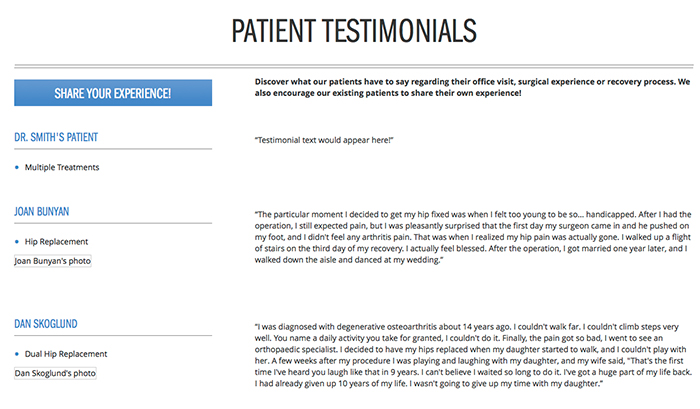As the old saying goes, you shouldn’t put all of your eggs in one basket. Likewise, you shouldn’t stick to just one marketing strategy for your practice, either. Incorporate different elements into your strategy for the best return on your investment.
Below are 60 different ways you can market your practice, grouped by type of effort (including SEO, community outreach, patient communication, etc.).
We hope these suggestions put you well on your way to developing a solid and scalable marketing strategy for your medical practice.
Don’t have time to read it all now?
Download the 60 Ways to Market Your Practice guide.

Overview
Section 1: Optimize Your Web Presence
Your web presence is the “home base” of your marketing efforts. Even if patients don’t initially hear about your practice online, they are likely to go online to learn more about you. For that reason, it’s important to optimize your web presence to ensure patients are able to find you and get the information they need.
1. Get a website to serve as a central hub of information about your practice.
According to Pew Research Center, 72% of U.S. adults have searched for health information online. This means that if you want to attract new patients, you’ll need to market yourself online. There are lots of different ways you can market yourself, as you’ll see below, but you have the most control over the patient experience on your website.
Don’t have a website? You’ll definitely want to get one if you want to be able to compete with other practices in your area.
Your website is the one location that you can always drive patients to with any of your marketing efforts to give more information. Though a professional, well-built website is a more costly investment upfront, it will pay off in the long run.
2. Make sure your website is mobile-friendly to attract patients on mobile devices.
Not only do you need to have a website, you also need to make sure it’s mobile-friendly. Is it easy to navigate your site on a smartphone or tablet? If not, it’s time to consider getting a responsive, mobile-friendly site. Google has been issuing warnings to sites that aren’t mobile-friendly, saying that these sites may not rank well in search results.
We’ve built nearly 1,000 healthcare practice websites at P3 Inbound. Across all of our websites, we’ve seen an average of 40% of a practice’s online traffic come from mobile phones and tablets. This percentage is often higher in larger metropolitan areas. You certainly don’t want to miss out on that much traffic.

Depending on when your current website was built, you may already have a solution in place for mobile. If you aren’t sure, we definitely recommend checking with your web provider.
The best option is to use a web provider that uses responsive design, as this will allow your website to adapt to a wide range of screen sizes, auto-fitting the content so that your patients always get the best experience.
3. Implement SEO best practices to improve your ranking in search engines.
Search engines are constantly evolving, and in order to get a favorable spot in search results, you need to follow the best practices of search engine optimization (SEO).
Weed out things like low-quality or duplicate content, and avoid using spam tactics like keyword stuffing and link scheming. A good SEO strategy should focus on quality content, local listings, and other, more technical optimization. To really improve your SEO strategy, it’s a good idea to work with someone who specializes in SEO. By working with an expert, you can improve SEO and develop a plan to keep your website optimized as you add and update content.
4. Create custom content for your website to attract patients seeking specific procedures & services.
Quality custom content should be a part of your SEO plan. You can create custom content to inform patients about your practice, qualifications, procedures, and services. Some practices write this content themselves, but you can also pay a content to help you put content together.
Quality content is an important factor in search engine ranking. It shows that you are knowledgeable and an expert in your field, which improves your chances of ranking for relevant searches. For example, a page that explains your expertise in hip replacement and answers common patient questions will improve your chances of showing up in search results when local patients search for a hip replacement surgeon.
Please, don’t try “shortcut” tactics. They can actually hurt your chances of ranking. Instead, create content with your patients in mind. What information do they want and need to know? Search engines are now intuitive enough to figure out whether or not you are providing quality information, so stuffing the content with the keywords you want won’t work. However, if you have well-written content with accurate, descriptive information, search engines will recognize it and award you with better ranking.
5. Claim your local listings to help patients find your practice.
Once a patient has decided to schedule an appointment with your practice, he or she will need to know where to find you. This is where local listings come in.
If you claim and verify your local listings in search engines like Google, Bing, and Yahoo, these search engines will display that information when patients in your area search for you. If your listing doesn’t show up, or your listing information is incorrect, your new patients may have a hard time finding you and get frustrated.
Managing your listing does take some effort upfront to get all of your listings claimed and up to date, but maintenance is fairly simple once you get that done. You’ll really only need to check in if you need to change something, or if you get a notification about a user-submitted change.
Although many listing services are free, you can also use a paid service if you don’t feel your office has the time to keep up. Automated services like Moz Local and BrightLocal allow you to make changes in one place, then push those changes out to several major online directories at once.
6. Optimize your local listings so patients can quickly find the important details about your practice.
Once your listing is claimed and verified, don’t stop there! Fill out as much information as possible to make your listing stand out and improve your chances of showing up in search results. Currently, Google only shows 3 map listings on the first page of search results, so it’s important to optimize your listings as much as possible to get that prime placement in the map results.
Add photos of your practice, fill out hours and specialties, and add a short description about your practice. The more information you can give, the better. Google My Business is also constantly rolling out features like user-submitted Q&A functionality, so make sure you stay on top of the latest online listing features so that you can be prepared.
7. Regularly update your website so patients can always get the latest information about your practice.
If your website contains old, outdated information and potential patients can’t find the information they are looking for, they may get frustrated and move on. It’s important to check for updates periodically to avoid this frustration. If your website has a content management system, it should be relatively easy to make updates to your content.
In addition to keeping your website content up to date, you also need to keep your site up to speed with the latest technology. If your site is very old, it may not be up to date with all of the latest security and functionality standards. This can create more frustration or distrust among your patients, and may eventually cause you to lose search engine ranking. In fact, Google Chrome has started marking non-secured websites as “Not Secure” in the browser bar. We suggest going with a website platform that regularly rolls out updates so that your practice’s website always utilizes the latest technology available.
8. Start a blog to share helpful tips and information with your patients on your website.
Blogs are a great way to continue adding content to your website on a regular basis. This content should differ from your other website content (see #4). Rather than explaining your procedures and services, you can give health tips (#17), talk about innovations in healthcare, give injury prevention tips, or any other relevant topics your audience would be interested in.
Blogging is more of an advanced strategy we’d recommend trying after tackling things like mobile-friendliness, SEO, and improving other content throughout your website.
9. Help your patients find your website so they know you have an online presence.
This one’s pretty simple: If you have a website or are on social media, let your patients know! They won’t know to look for you if they don’t know you’re out there! Put up “Find us on Facebook” or “Visit our website” signs in your office, and include that information in your marketing materials, too.
10. Use review sites like HealthGrades and RateMDs to establish your reputation online.

Review sites like HealthGrades and RateMDs are becoming increasingly popular among patients. Current or former patients can leave reviews about the quality of care they received at your practice, and new patients will often look at those reviews when researching to find a new doctor. Online reviews are even becoming more prevalent in search results, and may also factor into your search ranking.
If you don’t have time to solicit reviews from patients, you can use a service like our Reputation Marketing offering to collect reviews from patients in-office and post those reviews to key review sites.
11. Respond to online comments & reviews to show patients that you care about what they have to say.
Review sites and social media pages allow other users to leave reviews and comment on your posts. Don’t just ignore those comments! This opens up the door for you to engage with your patients. It could be as simple as thanking a patient for a positive review, or you could engage in a conversation.
You shouldn’t ignore negative reviews, either. Respond in a professional, well-thought-out way, and provide a way for the patient to resolve the issue with you offline. Even if you have some negative responses, if other potential patients see that you have taken the time to address those concerns, it could help to quell some doubts about your practice. Our Reputation Marketing service even helps you keep track of negative reviews, so that you can respond right away.
12. Get patient testimonials to reinforce your marketing messages.
Patient testimonials are a great addition for your website. Testimonials show the success stories of patients under your care, which can be reassuring to new patients. You can make it easy for patients to submit testimonials via a form on your website. We also recommend placing relevant quotes from your testimonials throughout your website and marketing materials to reinforce your marketing (just make sure you have the right permissions in place with your patients before doing so).

13. Make sure your site is ADA-compliant.
Recent lawsuits over web accessibility have set precedents that make ADA compliant websites almost a necessity. However, many practices fail in this area. Beyond protecting your practice from potential lawsuits, though, having an accessible website just makes things easier for patients with certain disabilities.
As a medical practice, certainly you take care of patients with a variety of different physical, visual, hearing, and cognitive disabilities. Wouldn’t you want those patients to be able to navigate your website as easily as your able-bodied patients? Having an ADA-compliant website signals to disabled patients that you are ready to help them, which can go a long way in terms of patient trust and loyalty.
Section 2: Patient Experience & Communication
By improving your communication with current patients and working to provide the best experience possible, you can make a lasting impression. When patients are happy with your practice, they will recommend you to friends and family who need your services. Word-of-mouth is a powerful tool, and the right patient experience and communication efforts can ensure that your patients will sing your praises.

Do you need to focus on getting more word-of-mouth recommendations from patients?
Take our Word of Mouth Quiz to find out! If your score says that you have room to improve on patient recommendations, refer back to this section for ideas to boost patient engagement.
14. Try out email marketing to stay in touch with your patients on a regular basis.
Email marketing is a great way to communicate with your patients and can be very beneficial to your practice. You can use email to send out routine information like appointment reminders, but you can also use email to send out marketing materials like newsletters (#16), upcoming events, or health tips (#17). When your patients opt-in to email newsletters or health tips, it gives you another way to keep communicating with your patients even if they don’t need to visit your office regularly (just be sure to remove them from your lists if they request to be removed).
Email marketing systems like Constant Contact and MailChimp also allow you to target your audience so you only send emails to people who can use the information you are sending out, and you can automate your messages so the actual sending process doesn’t take up a lot of your time.
15. Don’t forget about direct mail, though–you can grab patients’ attention there, too.

In a world where we are used to using email for our day-to-day communications, direct mail can make an impact–as long as you use it thoughtfully. When a new patient comes to your practice, send out a “Welcome to the Practice” letter. Also, since you have your patients’ birthdays on file, you can send out birthday cards. Appointment reminders for upcoming checkups can also be sent via direct mail. Small, personal touches like this will really stand out to your patients and make them feel welcome in your practice.
16. Send out newsletters (email, print, or both) to stay in contact with patients on a regular basis.
Newsletters are a great way to keep your patients informed. Your newsletter may include news articles related to different conditions you treat, health tips (#17), articles from your blog (#8), events in the community (#53), or a combination of those items. You may have to try out different types of content to figure out what works for your practice, or conduct a survey (#23) to find out which types of content patients want to read.
In the midst of the rapid changes throughout 2020, practices that had already built up their email lists were much better positioned to keep people informed with what services were currently available and what telehealth options patients could select.

If you do email marketing (#14) in a system like MailChimp or Constant Contact, you can create newsletter templates to expedite the process of getting the newsletter sent out.
If you have enough demand and the resources, you can also create a print version of your newsletter and mail it out to patients or keep some copies in your office for patients to pick up. Just remember, whether you’re sending newsletters to patients via email or regular mail, you’ll only want to send them to those who opt in to the service.
17. Give out health tips to show patients you care about their health.
By giving out health tips, you are reassuring patients that you care about their well-being, even when they don’t need to come in to your office. This can be helpful in building trust with your patients and retaining your current patients.
You can send out health tips in a number of places: on social media (#42), in your newsletter (#16), or in blog posts (#8). Try sending out periodic emails with health tips as part of your email marketing plan (#14). You could email a health tip every week to patients who opt-in, or try a “Health Tip of the Day” on social media.
18. Send out appointment reminders to remind patients when to come into your office.
Patients appreciate extra attention like appointment reminders. This also helps ensure that your patients actually show up to their scheduled appointments. If your practice uses a HIPAA-compliant appointment reminder system, or an EHR (#22), it’s quite simple to automate appointment reminders. If you have a smaller practice and the staff available to do it, you could also call your patients to remind them of appointments. This is a great chance to inform patients if there have been any changes in procedures.
19. Produce pamphlets and brochures to give patients information about your procedures and services.

Pamphlets and brochures can help to inform patients about your practice, your services, and the conditions you treat. Be sure to incorporate your branding. You can give these brochures to new patients, have them in your office for patients to pick up, add them to care packages (see #28), or give them out at health fairs (#54) and other events. This marketing method may be a good option to have handy for patients who aren’t comfortable using the internet to find healthcare information.
20. Offer take-away items to reinforce your branding and keep your practice top-of-mind for patients.
Everyone loves a freebie! Send your patients home with items that have your practice’s branding. It doesn’t have to be anything big or expensive–items like pens, magnets, and notepads are all small and relatively inexpensive to produce. Be sure to include your practice’s phone number so they’ll always have it handy. It’s another little reminder about your practice, so that patients know who to call when they need healthcare.
21. Focus on patient experience and quality of care to retain current patients and attract new patients through word-of-mouth.

Your ultimate goal as a practice should be to provide the best care possible to your patients. Other marketing efforts can help you get patients in the door, but if you want them to stay and recommend you to others, you have to make sure that every aspect of care is of the highest quality possible.
Remember, word-of-mouth is a powerful tool. Give your patients an experience that they’ll want to tell others about. It may be helpful to use patient surveys (#23) to learn more about what patients think of the experience at your practice.
22. Use an EHR to provide an easy way for patients to access their records.
Electronic health records (EHRs) can help your practice stay organized and allow patients to easily access their health information. More and more, patients want information about every aspect of their care so that they can make informed decisions. Having an EHR could be a big selling point to patients who want to be actively involved in their care.
23. Conduct patient surveys to identify areas to improve.
Are your patients satisfied with the care they are receiving? Do they like your facilities? Is the wait time too long? Find out what patients think by asking them to fill out a survey. Surveys can help you find out if you’re staying on track with patients’ expectations, or if you have areas where you need to improve.
Our Reputation Marketing survey includes questions that help you gather information about patient satisfaction, and has the added benefit of helping you collect online reviews. You can also put together and hand out your own surveys at the end of the appointment.
24. Answer patients’ questions (FAQs) so that the information is readily available.
There are probably some questions that patients ask fairly often. This is where Frequently Asked Questions (FAQs) come in handy. You can write up FAQs as part of your website content (#4), blog content (#8), or include them in your brochures or pamphlets (#19). Patients will appreciate the effort to answer their questions before they even have to ask them.
25. Get quality patient education to provide an easily-accessible, helpful reference for patients.
Patients will have questions about their conditions or the procedures they need to have, and patient education gives you a trustworthy resource to point them to. Patient education also helps to answer any questions a patient may think of after he or she has left your office. While patient education typically won’t help you rank in search engines (because the content is typically placed on multiple practices’ websites), there is a lot of value in having it for the convenience of your patients.
26. Make yourself more accessible to patients so they have an easy way to contact you.
Patients really appreciate a doctor who is willing to address any questions or concerns outside of the office. Offer a phone number or email address where patients can contact you, and try to respond as soon as you can. If you’re not comfortable giving out your personal information, even having a contact form or an email address dedicated to patient questions could be helpful. Just be sure you’re using a secure, HIPAA-compliant email account or contact form.
27. Add new procedures and services that enhance the patient experience.
The healthcare field is constantly evolving, and you need to be able to keep up with the latest advancements. Offering new procedures will appeal to patients seeking the most advanced care possible.
Outside of surgery, you can do things that make care more convenient for your patients, like adding on-site physical therapy. You also can also add lower-investment amenities to make patients feel more comfortable in your office, like free Wi-Fi or more comfortable seating in your waiting room. Little things like that can add up for patients.
28. Give care packages to patients to reinforce your brand and provide useful items.
Care packages could include brochures and takeaway items like pens, magnets, notepads, etc. You can give different types of care packages to different patients. New patients could get a package containing information about your practice and what they’ll need to know. You can also give care packages to patients who have just been diagnosed with a particular condition and provide information on how to manage that condition.
29. Offer telemedicine appointments.
There has been an increasing demand for virtual appointments, and the COVID-19 pandemic only served to rapidly increase that demand. Whether people would prefer to stay home to avoid an exposure risk, feel too busy to make time for an in-office appointment, or simply feel more comfortable in their own homes, telemedicine appointments can be a big value-add for patients.
Of course, not every type of appointment can be done virtually, but perhaps certain visits like initial consultations or follow-ups could be done on a virtual platform. There are also now several telemedicine platforms your practice can work with to offer this solution in a HIPAA compliant manner that is easy for patients and providers to use.
30. Offer online appointment booking or requests.
Today’s patients find value in convenience, and online appointment request options deliver on that. Patients who work during the day may not have time to call your office during open hours to schedule an appointment, especially if your phone lines are usually busy and people have to wait on hold. Others simply don’t like making phone calls. Whatever the reasoning might be, it’s quick and easy for a patient to be able to go online, fill out a short form, and be able to either directly schedule or request an appointment. Practices that don’t offer this option may very well be losing patients to practices that do.
31. Send texts or automated phone calls to confirm and remind patients of upcoming appointments.
When scheduled office visits or follow-up appointments are booked weeks out, it’s easy for patients to forget about them. Make sure your patients remember their appointments by sending out automated reminders. There are services that will automate this for you, so your staff doesn’t have to spend time making the phone calls themselves. Not only can it help prevent no-shows, but patients also appreciate the reminders.
32. Send out Happy Birthday messages.
Whether you send out birthday messages in the mail, via text, or via email, it’s a nice way to stay connected with patients in a way that isn’t transactional. Most other communications patients receive from your practice are related to appointments, billing, test results, etc., so it can be a nice touch for a patient to receive something with well wishes that doesn’t require any further followup.
33. Use a patient portal to allow patients to communicate, view test results, pay bills, etc. online.
This also goes back to the desire for convenience with today’s patients. People can complete many common tasks online now, from ordering household essentials, getting food and groceries delivered, paying bills, and seeking out other services. They have naturally come to expect the same options from their healthcare providers. For patients who work or otherwise lead busy lives, patient portals are a quick and easy way to manage their healthcare needs on the go. These convenient options can ultimately help with patient satisfaction and retention.
Section 3: Advertising & Media Efforts
Once you’ve established your practice’s web presence, advertising and media efforts are a great way to take your marketing to the next level. These efforts will help you get in front of patients who may not have heard of you through online searches or word-of-mouth.
34. Establish branding for your practice so you’re easily recognizable in the community.
Branding will help patients be able to instantly recognize your practice throughout different mediums–your website, social media, blog, advertising, etc. Choose a color scheme, logo, and practice name that looks professional and makes your practice stand out from others in the area. Keep the branding consistent throughout all of your marketing efforts so that patients can easily identify information that is coming from your practice.
Unless your practice is large enough to have an in-house marketing team that handles graphic design, you’ll probably need to hire a company to help with your branding needs. You’ll also need to pass on any branding details to any team members or companies who help manage your various marketing efforts, including your website, social media, and print media.
35. Focus on what sets you apart from other practices to differentiate yourself.
This is especially important if your practice is located in a highly competitive area. When a patient is searching for a new doctor, they want as much information as possible to be able to make an informed decision. For example, if there are 5 orthopedic surgeons in your city, but your practice is the only one that offers a certain technique or treatment approach, that’s something you’ll want to point out on your website and in your other marketing efforts.
A lot of this can be accomplished through your content marketing efforts. Make sure the content on your website is not only informative, but shows how your practice is different. These details may be the deciding factor for patients when comparing your practice to others in the area.
36. Run some “traditional” print ads or billboards.
Have an event coming up, or want to announce a new location or addition to the practice? Print ads and billboards are a great marketing tactic to grab the attention of your local audience. You can try running print ads in local newspapers and magazines–just make sure that the publications you are selecting work for your target audience. For example, a local magazine targeted to parents of young children would be the perfect place for a pediatric practice to advertise, but it probably isn’t the best option for an orthopedic surgeon specializing in joint replacements.
Billboards can be a bit trickier in terms of targeting because you never know who might drive by. Here, you want to aim for volume, selecting placement in high-traffic areas when possible.
37. Try radio or television commercials.
Radio and TV commercials are another great option for getting in front of local patients, provided you have the budget to do it well. Radio commercials may be easier to get going (and potentially cheaper) than TV, since all you need to do is provide the content for the announcer to read. Sometimes you can even sponsor local shows to get prime placement for your ad. TV commercials will require a higher budget since you will need someone to shoot, direct, and edit the commercial in addition to paying for the ad placement. However, the visual element may have more of an impact on your audience. In either case, make sure you are running the ads on programs your target patients would be most likely to watch or listen to.
38. Send out press releases to notify patients about upcoming events.
This isn’t something you need to do frequently, unless you have several events going on. Press releases are a good way to help get the word out about events in the community like a speaking engagement, an open house, or a health fair. You can email local news outlets to see if they will publish the information. There are no guarantees that your event will be run if you don’t pay for ad placement, but it’s worth a shot if advertising isn’t in your budget.
39. Run a paid search campaign to get in front of patients searching for a doctor online.
Paid search is a quick way to drive traffic to your website, and it can be very useful if you target it correctly. Advertising on search engines is great if you’ve just launched a new website and want to get some exposure. Paid search can also help you get highly-targeted traffic from patients seeking out specific procedures and services.
However, you’ll want to supplement your paid search campaign with other marketing efforts–traffic from paid search will end once your end your campaign. We also recommend implementing some form of tracking for online appointment requests so that you can track your return on investment and adjust the campaign accordingly.
40. Optimize your landing pages for your ads so patients find the information they need right away.
If you’re running a paid search campaign (#39), you want to make sure you’re sending your visitors to a page that contains useful information and answers their questions. This increases the chances that these patients will move forward with booking an appointment. You may have to do some research and try out different things to figure out what works best. If you’re working with a paid search specialist, that person may be able to provide some guidance in optimizing your landing pages.
41. Know your peak season to figure out when to invest in marketing.
If your practice is located in an area that is a popular vacation destination, you can target your marketing efforts to those patients. For example, during the winter, some patients living in colder areas may spend the season in a warmer area, and they may need a local doctor. These patients are often called snowbirds. If your practice is located in a popular winter retreat destination, you can start targeting your advertising to those patients before the season begins.
42. Get on social media media to connect with your patients.

Social media can be a great way to connect with your patients and relevant influencers, and it is another area that can help to solidify your branding (see #34).
Facebook and Twitter are great for connecting with your patients, posting health tips (see #17), sharing your blog articles (see #8), or posting announcements about events and news related to your practice.
You don’t have to be on every platform available–just make sure that you are able to keep up and post regularly to the networks you do decide to join. Make a plan if needed to help you stay on track.
Social media’s reach is unparalleled for the ability to get in front of your current and prospective patients immediately. Just be prepared to boost your posts. Social media is definitely a “pay to play” space these days.
43. Get on YouTube to share videos with your patients.
YouTube videos can be great additions to your website and very useful educational tools for your patients. They can also help new patients get acquainted with doctors before they book that first appointment–it helps them attach a face and a personality to the information. YouTube videos can be used to share health tips (see #17), explain procedures and services, and share the outcomes of certain procedures (ex. a patient walking after having a knee replacement procedure at your practice).
Just make sure to avoid anything too graphic, like a video of a surgical procedure–it may be off-putting to some patients. Dr. Mike Evans has become very well-known for his illustrated YouTube videos–they still get the point across without being gory. While you may not be able to produce illustrated videos, the idea of non-graphic, compelling images is something that you could incorporate into your video strategy.
44. Contribute to a publication (print or online) to get your doctors in front of a wider audience.
If you enjoy writing blog articles, you might want to consider contributing to other publications. That could mean writing a health column for a local newspaper or magazine, or contributing to another blog. Aim for something that has a wider reach than your own blog. You may have to start with smaller blogs and publications first, but if it goes well, you could work your way up to larger publications.
45. Put up an “Accepting New Patients” sign to let patients know you have openings in your schedule.
This one is pretty self-explanatory. It lets people know that you are welcoming new patients when other practices in the area might be full. If patients have a more urgent need for healthcare, having sooner availability is a big plus, so it’s worth the effort to let people know. You may also be able to add it to your website by adding a banner or placing the notice in a prominent place on the homepage.
46. Do local news interviews to share advice and expertise with local patients.
Whether you do a regular health segment or are interviewed for a news story related to your area of expertise, appearing on the local news station is another way to get your name out there. If the news station likes working with you, and there is good viewer response, you may become the station’s regular “go-to” for health-related information.
47. Target family members of potential patients who may be making appointments on their behalf.
Often, people are searching for medical advice on behalf of an older family member, like a parent or grandparent. So, if you primarily perform hip replacements on elderly patients, don’t assume that having an online presence won’t help your practice. In many cases, you’ll find that a patient’s child or grandchild found you online. Keep that in mind when coming up with your marketing plan. In particular, you can target online advertising to specific age groups to make sure you reach the right audience.
48. Get published in medical journals to show off your expertise and research.
Medical journals allow you to show off your expertise in a particular topic to the medical community. Medical journals are much more in-depth and research-based, unlike the other publications we talked about in #44. You can reference or link to these studies on your bio pages on your website, or cite statistics from your studies on your website to give patients information about expected outcomes. This can help reassure patients of your expertise in a particular procedure.
49. Do podcasts to share information on relevant topics.

Podcasts are another way to share your expertise on different topics and provide information to your patients. Podcasts will allow you to share information in an audio format, which may help patients who don’t have time to read through content. If your practice cares for chronic conditions, podcasts could also be a helpful way to share information on topics affecting your patients. You could also bring patients on as guests to talk about their experiences.
50. Get professional photography for your staff/office photos.
While anyone can snap a decent-looking photo with a smartphone these days, professional photography can really go a long way toward making your marketing efforts look professional and cohesive. A professional photographer will make sure that each photo has the optimal lighting and angle to keep your practice looking its best. In addition to staff photos, we also recommend getting some professional photos of your office to give patients an idea of what to expect when they visit you.
You can then take these photos and use them throughout your marketing efforts, from your website and social media to print and digital ads.
Section 4: Local Outreach Efforts
Getting involved in your community and getting to know your local network of physicians helps get your name out there in a different way than more traditional marketing efforts. When you make a good impression on patients and colleagues, they are more likely to remember you when your services are needed. Just by making the effort to get out there and get to know people in your local area, you can bring in more referrals to your practice.
Perhaps no other section in this set of marketing recommendations requires as much creative thinking as this one. COVID-19 definitely changed some of the ways that we can implement these tactics, but virtual options are often available. Keep a look out for where you can connect with patients digitally, and be ready to connect in person as it’s available in your area.

Should your practice be doing more to connect with local patients and providers in the community?
Take our Word of Mouth quiz to find out! If your score indicates that you have room for improvement, refer back to this section for ideas on how to ramp up local outreach efforts.
51. Ask local physicians for referrals to your practice.
Referrals are a great (and potentially free!) way to get the word out about your practice. Other marketing channels can vary with the amount of patients that come in, but a good referral partner can help you get more patients who are a good fit for your specialties. Connect with colleagues in different specialties to learn more about what they do and how you might be able to refer patients to one another.
52. Claim your Doximity profile to connect with colleagues and build your referral base.
Doximity is often referred to as the “LinkedIn for doctors,” but it provides a lot of other benefits as well. You can share information about difficult or unusual cases with other doctors through a secure, HIPAA-compliant network, get referrals from other doctors, and help with remote consultations. See our blog post about Doximity to learn more about the benefits it offers.
53. Get involved in your community so patients can get to know you.
Getting out in your community helps patients recognize you for your positive work. It also helps you connect with patients outside of the office or hospital environment. Whether you participate in charity fundraising events, donate your time and services, or do public speaking engagements (see #’s 54-60 below for ideas), there’s a lot your practice can do to get involved.
54. Go to health fairs to connect with patients who may benefit from your services.
Health fairs can help you reach out to people who may have been unaware of your practice. Health fairs are another opportunity to offer free screenings and services to people in your community. Having a booth at a health fair can also help you to build brand awareness (see #34) so that patients will remember you.
55. Offer free screenings or services to let patients “try out” your practice.
This gives new patients a chance to “sample” your care approach and services. It could be something as simple as free blood pressure screenings. You could even try a free flu shot to the first 10 patients who visit your flu clinic. This can help you attract patients who might have otherwise gone to a retail or pharmacy-based clinic.
56. Participate in public speaking events and seminars to show off your knowledge and expertise.

Speaking events and seminars are a way to help show off your expertise on a particular topic. Seminars and speaking events can help inform patients (to explain management of a chronic condition, for example), or to present new information or research studies to others in the healthcare community.
57. Have an open house house so patients can learn more about your office and meet your staff.
This is very useful if you have a new office location or facility. Open houses allow potential patients to see facilities and meet your staff. It also gives patients the opportunity to discuss your care philosophy to determine whether your practice is the right fit. The American Academy of Family Physicians has some detailed tips on how to plan an open house that may be helpful if you decide to go this route.
58. Get involved with the local chamber of commerce to identify opportunities within your community.
Your local chamber of commerce can help you identify other opportunities to get involved with other businesses and the community. It’s a great resource to have at your disposal if you want to get your practice out there.
59. Host dinners for local primary care providers.
Sending out brochures to local PCPs is a good way to initially introduce your practice and help these potential referral sources learn more about your specialties. Hosting dinners or other social events that are open to local primary care physicians can take that a step further by helping those practices get to know you. Naturally, local PCPs will be more likely to refer patients to know if they know and like you, and a dinner is a great way to start that relationship. This may be especially if your practice is new in town, or if your providers are from out of town and don’t have any local connections.
60. Sponsor local events or school sports teams.
When your practice is a sponsor for local events or sports teams, you are usually awarded with some sort of promotion, usually by being listed among the sponsors or having your logo or banner featured at events. This is a great way to stay top of mind with local patients, whether they need your services now or might need them in the future. It shows patients that you are invested in your community, which goes a long way with building trust.




